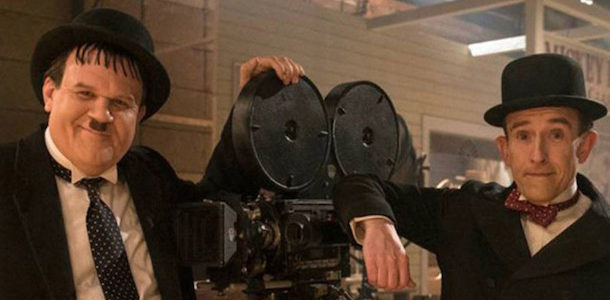
ReelBob: ‘Stan & Ollie’ ★★★
By Bob Bloom
“Stan & Ollie” is an affectionate portrait of the comedic duo in the twilight of their careers and their lives.
The movie, set during their tour of English music halls in 1953, follows the two veteran performers struggling to reignite their careers — and be relevant again.
Laurel and Hardy was one of the most popular comedy teams of the 1930s, making dozens of shorts and feature films at the Hal Roach Studio.
But changing times and post-World War II tastes — and the emergence of such newer comedy teams in the 1940s and ’50s as Abbott and Costello and Dean Martin and Jerry Lewis — eclipsed their popularity. After leaving Roach, the films they made for other studios lacked the magic of their earlier efforts and offers began to dry up.
To many in that postwar era, Laurel and Hardy’s slapstick routines seemed quaint and dated.
In “Stan & Ollie,” the veteran comedians are touring in small theaters around England while waiting to hear from a movie producer about the startup for what could be their comeback project — a Robin Hood spoof called “Rob ’Em Good.”
“Stan & Ollie” looks at two tired, aging performers working hard to recapture the spotlight, even though, down deep, they know their time has passed.
A slight whiff of melancholy looms over “Stan & Ollie,” but it is tempered by the endearing and spot-on performances by Steven Coogan and John C. Reilly. Both do much more than impersonate their characters — they inhabit them.
And while both capture the physical mannerisms and speech patterns of the duo, the heart and soul of the movie is the relationship between Stan Laurel and Oliver Hardy — as well as the tensions and recriminations that fester in a decades-long relationship.
Laurel may have played the “dumb” character, but he truly was the brains of the team. Laurel, who began his career in the English music halls, was an understudy to Charlie Chaplin in the early 1900s. And, like Chaplin, Stan Laurel was a driven perfectionist. He created the bulk of Laurel and Hardy’s famous routines and had input on their movies made for Roach.
Oliver Hardy was more casual. To him, acting was a job. He preferred spending his free hours on the golf course or at a baseball game, instead of, like his partner, in the editing room.
At various times in their career, this caused some minor conflict between them as Laurel came to resent — what he considered — his costar’s lackadaisical attitude toward the various stages of their work.
Some of this comes to a head and is covered in “Stan & Ollie.” But, director Jon S. Baird, working from a script by Jeff Pope, seems to hold back, not wanting to show “the Boys” — as fans refer to them — in any disparaging manner.
This laid-back approach dissipates whatever tension the filmmakers try to create. It’s as if they are afraid to really burrow down — thus only skimming some of the warts of their beloved protagonists.
Coogan and Reilly are accomplished actors. Their physicality and abilities to recreate some of the duo’s well-known bits are extraordinary. And they are basically each playing two characters — the real-life Stan Laurel and Oliver Hardy and, when the script demands, easily transforming into their comic personas.
Coogan captures Laurel’s soft English accent and his distinct walk, while Reilly speaks in Hardy’s familiar voice that contains a distinct Southern drawl. (Hardy was born in Georgia, and, at times, his regional dialect came through in his performances.)
Also, worth mentioning, are the contributions of Shirley Henderson as Lucille Hardy and Nina Arianda as Ida Kitaeva Laurel. Their interactions nearly steal the movie. Lucille is fiercely protective of “Babe,” Hardy’s nickname, while Ida, who looks out for her man, as well, showcases a fiery Russian personality that is off-putting and a bit comical.
My main quibble with “Stan & Ollie” is the brief, one-note performance by Danny Huston as Hal Roach. Baird — or the script — has Huston portray Roach as the stereotypical tyrannical studio boss. And while in actuality the relationship between Laurel and Roach soured over the years because of issues centering on money and creative control of the team’s movies, Roach is not the crass monster the script offers.
I grew up watching the short films and features of Laurel & Hardy on television. As a kid, I simply laughed at their slapstick routines.
As an adult — and as I became more aware of various aspects of filmmaking — I came to appreciate their timing and the nearly balletic choreography that went into their slapstick routines.
The sequences of those routines recreated in “Stan & Ollie” are delightful, but the soul of the movie is the relationship between two actors thrown together through happenstance who forged a bond with audiences on screen and formed a deep, offscreen friendship late in their lives.
I am a founding member of the Indiana Film Journalists Association. My reviews appear at ReelBob (reelbob.com) and Rottentomatoes (www.rottentomatoes.com). I also review Blu-rays and DVDs. I can be reached by email at bobbloomjc@gmail.com or on Twitter @ReelBobBloom. Links to my reviews can be found on Facebook, Twitter, Google+ and LinkedIn.
STAN & OLLIE
3 stars out of 4
(PG), language, smoking